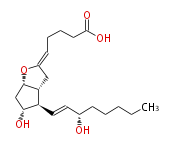LBF20207PG51: Difference between revisions
No edit summary |
No edit summary |
||
| Line 14: | Line 14: | ||
|Source=In most animal tissues prostanoids are synthesized enzymatically de novo upon physiological and pathological stimulations, and this is also the case of prostaglandin I2. Prostaglandin I2 is produced in blood vessels, lung and other tissues [[Reference:Moncada_S:Vane_JR:,Pharmacol. Rev.,1978,30,293|{{RelationTable/GetFirstAuthor|Reference:Moncada_S:Vane_JR:,Pharmacol. Rev.,1978,30,293}}]]. | |Source=In most animal tissues prostanoids are synthesized enzymatically de novo upon physiological and pathological stimulations, and this is also the case of prostaglandin I2. Prostaglandin I2 is produced in blood vessels, lung and other tissues [[Reference:Moncada_S:Vane_JR:,Pharmacol. Rev.,1978,30,293|{{RelationTable/GetFirstAuthor|Reference:Moncada_S:Vane_JR:,Pharmacol. Rev.,1978,30,293}}]]. | ||
|Chemical Synthesis=[[Reference:Johnson_RA:Lincoln_FH:Nidy_EG:Schneider_WP:Thompson_JL:Axen_U:,J. Am. Chem. Soc.,1978,100,7690|{{RelationTable/GetFirstAuthor|Reference:Johnson_RA:Lincoln_FH:Nidy_EG:Schneider_WP:Thompson_JL:Axen_U:,J. Am. Chem. Soc.,1978,100,7690}}]] {{Image200|LBF20207PG51FT0001.gif}} | |Chemical Synthesis=[[Reference:Johnson_RA:Lincoln_FH:Nidy_EG:Schneider_WP:Thompson_JL:Axen_U:,J. Am. Chem. Soc.,1978,100,7690|{{RelationTable/GetFirstAuthor|Reference:Johnson_RA:Lincoln_FH:Nidy_EG:Schneider_WP:Thompson_JL:Axen_U:,J. Am. Chem. Soc.,1978,100,7690}}]] {{Image200|LBF20207PG51FT0001.gif}} | ||
|Metabolism=Prostaaglandin I2 is produced by isomerization of 9,11-endoperoxide of prostaglandin H2 by the catalysis of prostaglandin I synthase [[Reference:Tanabe_T:Ullrich_V:,J. Lipid Mediat. Cell Signal.,1995,12,243|{{RelationTable/GetFirstAuthor|Reference:Tanabe_T:Ullrich_V:,J. Lipid Mediat. Cell Signal.,1995,12,243}}]]. Prostaglandin I2 is unstable and decomposes readily to 6-keto-prostaglandin F2<FONT FACE="Symbol">a</FONT>. Its 2,3-dinor derivative is a major urinary metabolite [[Reference:Needleman_P:Turk_J:Jakschik_BA:Morrison_AR:Lefkowith_JB:,Annu. Rev. Biochem.,1986,55,69|{{RelationTable/GetFirstAuthor|Reference:Needleman_P:Turk_J:Jakschik_BA:Morrison_AR:Lefkowith_JB:,Annu. Rev. Biochem.,1986,55,69}}]]. | |Metabolism=Prostaaglandin I2 is produced by isomerization of 9,11-endoperoxide of prostaglandin H2 by the catalysis of prostaglandin I synthase <!--0015-->[[Reference:Tanabe_T:Ullrich_V:,J. Lipid Mediat. Cell Signal.,1995,12,243|{{RelationTable/GetFirstAuthor|Reference:Tanabe_T:Ullrich_V:,J. Lipid Mediat. Cell Signal.,1995,12,243}}]]. Prostaglandin I2 is unstable and decomposes readily to 6-keto-prostaglandin F2<FONT FACE="Symbol">a</FONT>. Its 2,3-dinor derivative is a major urinary metabolite [[Reference:Needleman_P:Turk_J:Jakschik_BA:Morrison_AR:Lefkowith_JB:,Annu. Rev. Biochem.,1986,55,69|{{RelationTable/GetFirstAuthor|Reference:Needleman_P:Turk_J:Jakschik_BA:Morrison_AR:Lefkowith_JB:,Annu. Rev. Biochem.,1986,55,69}}]]. | ||
|Symbol=PGI2 | |Symbol=PGI2 | ||
|Biological Activity=Prostaglandin I2 is a potent anti-aggregatory agent for platelets, relaxes blood vessels, and enhances vascular permeability [[Reference:Whittle_BJ:Moncada_S:,Br. Med. Bull.,1983,39,232|{{RelationTable/GetFirstAuthor|Reference:Whittle_BJ:Moncada_S:,Br. Med. Bull.,1983,39,232}}]]. It binds to a receptor with 7 transmembrne domains (IP) coupled to a Gs protein [[Reference:Negishi_M:Sugimoto_Y:Ichikawa_A:,Biochim. Biophys. Acta,1995,1259,109|{{RelationTable/GetFirstAuthor|Reference:Negishi_M:Sugimoto_Y:Ichikawa_A:,Biochim. Biophys. Acta,1995,1259,109}}]]. | |Biological Activity=Prostaglandin I2 is a potent anti-aggregatory agent for platelets, relaxes blood vessels, and enhances vascular permeability [[Reference:Whittle_BJ:Moncada_S:,Br. Med. Bull.,1983,39,232|{{RelationTable/GetFirstAuthor|Reference:Whittle_BJ:Moncada_S:,Br. Med. Bull.,1983,39,232}}]]. It binds to a receptor with 7 transmembrne domains (IP) coupled to a Gs protein [[Reference:Negishi_M:Sugimoto_Y:Ichikawa_A:,Biochim. Biophys. Acta,1995,1259,109|{{RelationTable/GetFirstAuthor|Reference:Negishi_M:Sugimoto_Y:Ichikawa_A:,Biochim. Biophys. Acta,1995,1259,109}}]]. | ||
Revision as of 16:30, 26 January 2010
| LipidBank Top (トップ) |
Fatty acid (脂肪酸) |
Glycerolipid (グリセロ脂質) |
Sphingolipid (スフィンゴ脂質) |
Journals (雑誌一覧) |
How to edit (ページの書き方) |
| IDs and Links | |
|---|---|
| LipidBank | XPR1801 |
| LipidMaps | LMFA03010087 |
| CAS | |
| KEGG | {{{KEGG}}} |
| KNApSAcK | {{{KNApSAcK}}} |
| mol | LBF20207PG51 |
| PROSTAGLANDIN I2 | |
|---|---|

| |
| Structural Information | |
| 5 (Z) - [ 7 (R) -Hydroxy-6 (R) - (3 (S) -hydroxyocten-1 (E) -yl) -1 (S) ,5 (R) -2-oxabicyclo [ 3.3.0 ] oct-3-ylidenpentanoic acid | |
| |
| PGI2 | |
| Formula | C20H32O5 |
| Exact Mass | 352.224974134 |
| Average Mass | 352.46508 |
| SMILES | C(CC[C@@H](O)C=C[C@H]([C@H]12)[C@H](O)C[C@H](OC(C2)=CCCCC(O)=O)1)CC |
| Physicochemical Information | |
| [a]D=78°(C=0.8820, CHCl3) Johnson_RA et al. | |
| In most animal tissues prostanoids are synthesized enzymatically de novo upon physiological and pathological stimulations, and this is also the case of prostaglandin I2. Prostaglandin I2 is produced in blood vessels, lung and other tissues Moncada_S et al.. | |
Johnson_RA et al.  | |
| Prostaaglandin I2 is produced by isomerization of 9,11-endoperoxide of prostaglandin H2 by the catalysis of prostaglandin I synthase Tanabe_T et al.. Prostaglandin I2 is unstable and decomposes readily to 6-keto-prostaglandin F2a. Its 2,3-dinor derivative is a major urinary metabolite Needleman_P et al.. | |
| Prostaglandin I2 is a potent anti-aggregatory agent for platelets, relaxes blood vessels, and enhances vascular permeability Whittle_BJ et al.. It binds to a receptor with 7 transmembrne domains (IP) coupled to a Gs protein Negishi_M et al.. | |
| Spectral Information | |
| Mass Spectra | 11,15-BIS(TRIMETHYLSILYL) ETHER METHYL ESTER ; 495(M+-CH3), 479, 439, 423, 349, 327, 323, 315, 313, 199, 173 Johnson_RA et al. |
| UV Spectra | |
| IR Spectra | METHYL ESTER ; LIQUID MELT n 3370, 1740, 1695cm-1 Johnson_RA et al. |
| NMR Spectra | 1-H-NMR(D2O, GLYCINE BUFFER, pH10.4) : d 5.60(m, 2H, 13,14-CH), 4.66(m, 1H, 9-CH), 4.39(t, 1H, 5-CH), 4.15(q, 1H, 15-CH), 3.97(q, 1H, 11-CH), 2.20(t, 2H, 2-CH2) KotovychGet al. |
| Other Spectra | |
| Chromatograms | |
| Reported Metabolites, References | ||||||||||||||||||||||||||||||||||||||||||||||||||
|---|---|---|---|---|---|---|---|---|---|---|---|---|---|---|---|---|---|---|---|---|---|---|---|---|---|---|---|---|---|---|---|---|---|---|---|---|---|---|---|---|---|---|---|---|---|---|---|---|---|---|
|